Back in the late 1980s when the U.S. military retired the 1911 for the Beretta M9, the Marine Expeditionary Unit (Special Operations Capable), or MEUSOC, decided to stick with the 45 Auto 1911 platform because it was the only pistol at the time that could stand up to the use the MEUSOC teams doled out. The MEUSOC guys detailed the new features and specifications they wanted on their modernized version of the 1911, and the armorers at Quantico built the guns. Most of these guns were built on original, used M1911A1 G.I. frames. The remaining parts for the builds were a precise list that transformed the G.I. 1911s into modern combat handguns. MEUSOC operators provided feedback to the armorers on the guns, and there were four variations of these guns built. Some of the parts used in the builds reads like a who’s who of custom gun-builder pieces. Parts included Clark or Wilson Combat beavertail grip safeties, Pachmayr Gripper grips, MGW commander hammers, Videcki steel triggers, Bar-Sto barrels, Springfield Armory slides, Ed Brown safeties, Caspian mainspring housings, and more, all the way down to the smaller pins, the sear, and other parts. Common to all MEUSOC pistols were fixed sights, long triggers, G.I.-style muzzle bushings, and flat mainspring housings.
Some 1911 manufacturers produce pistols in the MEUSOC style, and we wanted to take a look at these guns. These newly-made MEUSOC 1911s are not exact copies of the Quantico builds. For example, the original specs called for a lanyard loop, which have no real use on modern commercial guns, other than impeding a magazine reload with a G.I. bump-pad-less mag. The three pistols we chose for this match up include the Military Armament Corporation (MAC) 1911 JSOC 45, the Springfield Armory 1911 Loaded Marine Corps Operator, and Rock Island Armory’s 1911 A1 Tact Standard FS. All three of these share a full-size frame, are chambered in 45 Auto, and feed from a single-stack magazine. From there, the interpretation of the MEUSOC guns takes some creative license, which is fine by us as long as it works, and we can say all three of these guns performed exceptionally well, with excellent accuracy, decent triggers, user-friendly sights, and texture where you need it on a 45 Auto 1911. If you are looking for a full-size 1911, any one of the these guns will fit the bill, but our shooters expressed some preferences that made one gun our pick over the others.
How We Tested
We shot for accuracy at 25 yards using a rest, and we moved in to 7 yards for the speed-shooting portion, where we ran a modified Bill Drill by firing as fast as we could into an 8-inch circle and performing reloads. We loaded different round counts into all the pistols’ magazines as well as using new Never Unarmed eight-round 1911 magazines ($18; NeverUnarmed.com). These steel-body magazines feature a polymer follower and bumper pad and look a lot like Wilson Combat magazines, except they are a fraction of the price. We tested for slide lock back and the ability to quickly load. The Never Unarmed magazines worked well, and for the price, we rate them a Best Buy. Slide lock back was positive with all three pistols, and the magazines inserted smoothly and clicked positively in place when seated and dropped free from the pistol when the magazine catch was pressed. We fired the pistol with and without shooting gloves. The trigger guard is not that big on 1911s, though we were able to easily use a variety of shooting gloves. All the magazines were compatible, except the Armscor mag, which couldn’t be inserted into the MAC because the bumper pad was not compatible with the MAC’s mag well.
Test ammunition was an assortment of defense and training loads. Armscor 230-grain FMJ ball ammo is similar to G.I.-style ammo and is a good choice for training. For defense loads, we used Hornady Critical Duty 45 Auto +P with a 220-grain FlexLock bullet and Winchester Silver Tips with 185-grain JHPs. If you are going to run a steady diet of +P ammo, we recommend installing a Wilson Combat Shok-Buff ($6.95; WilsonCombat.com) to protect the slide from battering the frame. You can use them with any ammo type and they last about 1,000 rounds before needing replacement. Shok-Buffs are for 5-inch-barrel 1911s only. There is not enough room for them in Commander and compact-size 1911s.
Average accuracy across the three ammo choices ranged from 2.43 inches for the RIA to 2.73 inches for the MAC. The Springfield was just behind the RIA with 2.46-inch average accuracy.
The heft of these pistols makes them easier to shoot faster. Speed-shooting groups measured 1.6 inches on average for the RIA, and 2.2 and 2.6 inches for the Springfield and MAC, respectively. In the speed-shooting section we didn’t count flyers; rather, we looked at the concentration of the holes or in some cases, one massive ragged hole.
We had two failure-to-feed jams with the MAC, and we attributed this to the 1911 being new and not having enough lube on the barrel. We sprayed Hoppe’s Gun Medic on the barrel without field-stripping the gun, and the MAC ran fine from that point forward.
Rock Island Armory 1911 A1Tact Standard FS 51484 45 Auto
$580
Gun Tests grade: A [best buy]
The Tact Standard might be where the MEUSOC 1911 evolved to if it were still being produced. The full dust cover offers a smidge extra weight that helps control the pistol. Accuracy was very good. The one-piece guide rod ensures the pistol cycles smoothly. Comparing features and performance with price, this 1911 is a bargain.
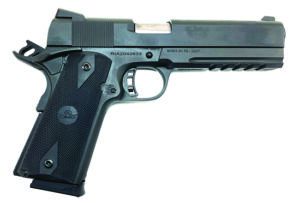
| Action | Locked breech, single-action semi-auto |
| Overall Length | 8.5 in. |
| Overall Height | 5.5 in. |
| Maximum Width | 1.4 in. |
| Weight Unloaded | 43.2 oz. |
| Weight Loaded | 49.8 oz. |
| Barrel | 5.0 in. |
| Capacity (Single Stack) | 8+1 |
| Slide | Steel, Parkerized finish |
| Slide Retraction Effort | 18.0 lbs. |
| Frame | Steel, Parkerized finish |
| Frame Front Strap Height | 2.5 in. |
| Frame Back Strap Height | 3.2 in. |
| Grips | Checkered rubber |
| Grip Thickness (Maximum) | 1.2 in. |
| Grip Circumference (Maximum) | 5.5 in. |
| Front Sight | Ramp |
| Rear Sight | Fixed notch |
| Trigger Pull Weight | 6.0 lbs. |
| Trigger Span | 2.7 in. |
| Magazines | 1; steel w/bumper pad |
| Safety | Manual thumb, beavertail grip |
| Warranty | Limited lifetime |
| Made In | Philippines |
| Website | Armscor.com |
The more we shoot RIA 1911s, the more we are impressed with their accuracy and build. Like most RIA 1911s, the Tact Standard wore a nice matte-black Parkerized finish that makes it look unpretentious, but the function is all there. The grips are checkered rubber that offers a nice stickiness to them and do not gnaw at the palm of your hand during extended shooting. This is a comfortable 45 Auto pistol to shoot. It checks the MEUSOC boxes by not having a mag well and having fixed snag-free combat-style sights, an ambidextrous thumb safety, and nice Ed Brown-style beavertail grip safety. From there, the Tact Standard changes. It has a full dust cover to add a tactical light and a full-length guide rod that makes the pistol cycle smoothly and adds weight to the front of the pistol. Overall, it weighs 43.2 ounces on an empty tank. That extra bit of weight at the muzzle helps control muzzle flip to get back on target faster.
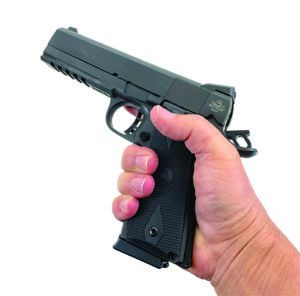
The domed slide is serrated only at the rear. We missed the forward slide serrations when doing a press check. The ramp front sight is plain black and dovetailed into the slide. The rear sight is snag-free and can be tapped left or right to adjust windage. The sights are black and can be lost on dark targets. If we had a small complaint, we’d want the front sight to pop more. The RIA shot dead on at 25 yards. Our best five-shot group at 25 yards measured 1.49 inches with Winchester Silver Tips loaded with a 185-grain JHP. Next best was the Hornady Critical Duty 45 Auto +P with a 220-grain FlexLock bullet at 2.21 inches. The Armscor ball ammo loaded with the 230-grain FMJ had a best group that measured 2.29 inches. The RIA turned out to be the most accurate pistol in the match up, besting the Springfield by 0.03 inch and the MAC by 0.33 inch. The one-piece guide rod offered smooth cycling.
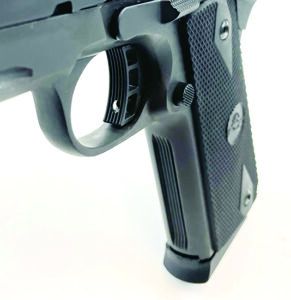
We had no issues using any of the 1911 magazines in the RIA. The trigger broke at 6 pounds — MEUSOC guns had 4- to 4.5-pound pull weights. We would like the trigger pull closer to 4 pounds, but the 6-pound weight did not hamper accuracy or speed shooting. The trigger is curved and serrated, so your finger stays put during recoil. There was about 1⁄8-inch of take up, then a crisp break. Reset was also about 1⁄8 inch. We liked the trigger. For some testers, wearing gloves slowed down reloading, depending on the material of the glove, and the sticky rubber grip took more effort to rotate the gun in our grip to firmly press the magazine release. Bare-handed, it was easier to manipulate. The rubber grip offers texture but did not rub against the web of our hands with extended shooting. The ambi thumb safety clicked on and off positively, and the beavertail allows you to get your hand deep into the gun for better recoil control. We had no issues with the Tact Standard.
The RIA came in a hard case with one magazine, which did not make us happy. One magazine does keep the cost down, however.
Our Team Said: The Tact Standard is a no-nonsense 1911 that offers great accuracy and smooth cycling. It is not a dead ringer for a MEUSOC, but it does offer a lot of features for a low price. This a 45 Auto that performs.
| 45 ACP RANGE DATA | |||
| Hornady Critical Duty 220-grain FlexLock (+P) | Military Armament Corp. 1911 JSOC 45 | Rock Island Armory 1911 A1 Tact Standard FS Marine Corps Operator | Springfield 1911 Loaded Marine Corps Operator |
| Average Velocity | 1054 fps | 1003 fps | 1052 fps |
| Muzzle Energy | 510 ft.-lbs. | 492 ft.-lbs. | 541 ft.-lbs. |
| Smallest Group | 2.46 in. | 2.21 in. | 2.06 in. |
| Average Group | 3.35 in. | 2.60 in. | 2.26 in. |
| Armscor 230-grain FMJ | Military Armament Corp. 1911 JSOC 45 | Rock Island Armory 1911 A1 Tact Standard FS | Springfield 1911 Loaded Marine Corps Operator |
| Average Velocity | 879 fps | 828 fps | 887 fps |
| Muzzle Energy | 394 ft.-lbs. | 350 ft.-lbs. | 401 ft.-lbs. |
| Smallest Group | 2.63 in. | 2.29 in. | 1.93 in. |
| Average Group | 2.71 in. | 2.37 in. | 2.20 in. |
| Winchester Silver Tip 185-grain JHP | Military Armament Corp. 1911 JSOC 45 | Rock Island Armory 1911 A1 Tact Standard FS | Springfield 1911 Loaded Marine Corps Operator |
| Average Velocity | 991 fps | 972 fps | 994 fps |
| Muzzle Energy | 403 ft.-lbs. | 388 ft.-lbs. | 406 ft.-lbs. |
| Smallest Group | 1.34 in. | 1.49 in. | 2.77 in. |
| Average Group | 2.15 in. | 2.33 in. | 2.93 in. |
To collect accuracy data, we fired five-shot groups at 25 yards from a bench using a rest. We recorded velocities using a Garmin Zero C1 Pro chronograph.
Written and photographed by Robert Sadowski, using evaluations from Gun Tests Team members. GT


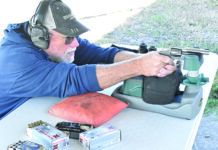
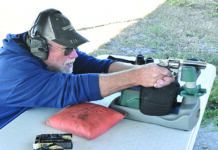
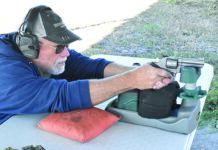
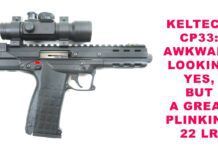
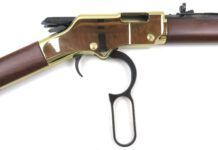
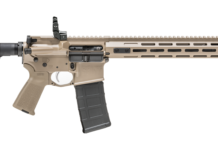
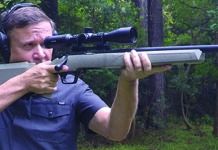
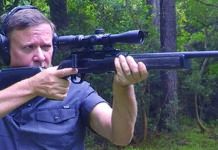


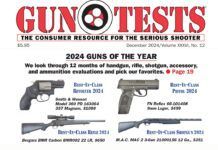


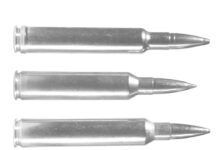
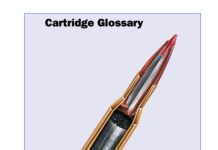
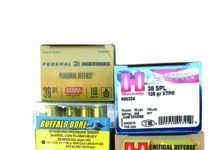
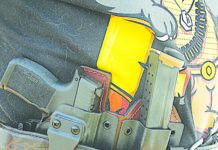


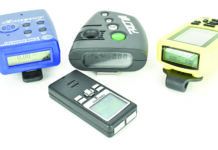



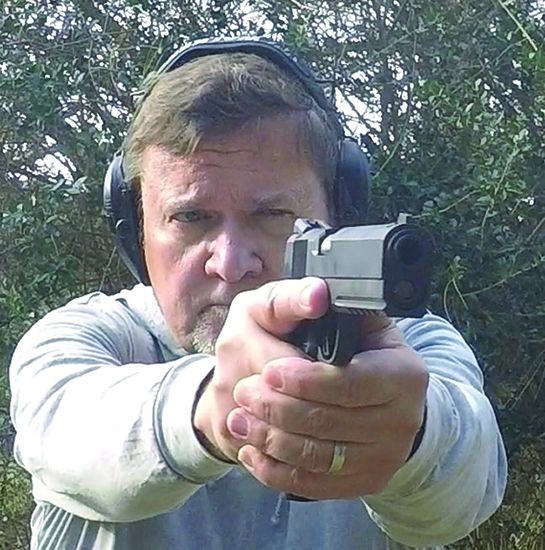

what were prices on other than your top choice?